It has long been used by Aboriginal and Torres Strait Islander peoples to explore and express ideas, tell stories, and pass on information. Using art as a vehicle for learning can assist students to investigate social realities, explore complex themes and issues and express their ideas creatively. Below is some information about different types of Aboriginal art and artists, some suggested activities and tips to create artwork entries for this year’s challenge.
Below are some of our Art activities and lesson plans – For Learning From Legacy: Healing Our Country activities click here.
What do you think of when you think of “Aboriginal Art”? For many, the image that comes to mind is of the Western Desert style of dot paintings. The truth is Aboriginal art comes in a range of forms and styles – there is no single “type” of Aboriginal art. An artwork will look very different depending on where it was made, when it was made, what it is about and the artist themselves. When we look at an artwork it is always important to think about the artist’s aim when they created it. In other words, “why was this artwork made?” or “what is the artist trying to say?”. For example, many artworks by Aboriginal and Torres Strait Islander people focus on their relationship with the land and connection to Country. Often when we create art, we are showing something about our own identity and what is important to us. Aboriginal and Torres Strait Islander artists today may choose to work in a more traditional or modern styles of art making.
My passion for art began when I was in high school spending countless lunchtimes on my own in the art room exploring my creativity, and learning, testing and understanding different mediums.
I am a proud Aboriginal woman, who is a descendant of the Murrawari through my Mother’s maternal side and Euahlayi through my Mother’s paternal grandmother and was encouraged by my art teachers to explore my Aboriginal art style. It was then that I went on to study my Bachelor of Creative Arts at Wollongong University NSW.
I’m well in tune with my senses and find my love for nature, animals and the landscape give me inspiration. I also find that smells, sounds and colours also have a big influence on my work.
The mural was commissioned by UrbanGrowth (Landcom) in partnership with Sydney Water and Campbelltown Council.
The design features elements of Edmondson Park from the past and present, which are demonstrated through an aerial view. There is a blue line running through the mural which represents Campbelltown Road and aspects from the past like vineyards and market gardens through to Indigenous elements.
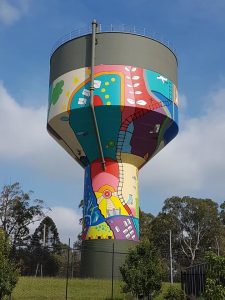
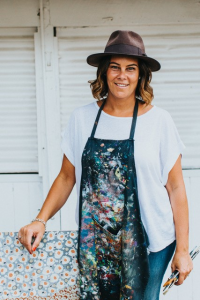
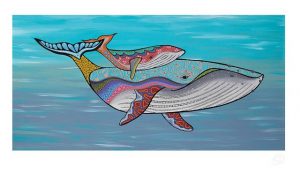
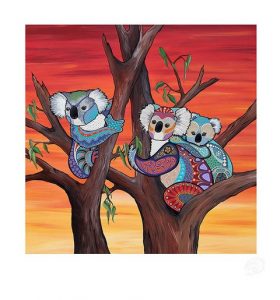
Check out Danielle Mate Sullivan’s’ artworks on her website and this article in order to answer the following questions:
My name is Zachary Bennett-Brook and I am a proud Torres Strait Islander man who lives in Wollongong, Dharawal Country, on the South Coast of NSW. In high school, I discovered my passion to paint the stories and artworks of my culture. My artwork combines my love for surfing and the ocean with my Torres Strait Islander heritage. I create artworks from recycled surf boards and fins, putting a modern twist and my own unique touch on traditional Indigenous Australian art. Growing up in the Gong I have always been surrounded by the ocean and have been addicted to sliding across the ‘ocean hills’ (what I like to call waves). I am a proud Torres Strait Islander man and we are known as the saltwater people. The ocean has always played a vital role in my life and I often draw inspiration from its blue walls and sandy floors. The colours and shapes of the sea are visible throughout my artworks and highlight my respect for the oceans beauty and power. I also draw inspiration from other creative people and their artworks. I love to watch people create, and looking at their final pieces always helps me to develop my own ideas. I strive to produce artworks that are of the highest quality and represent my passion for surfing and my Torres Strait Islander heritage. I believe that every artwork that I craft helps me to grow artistically.
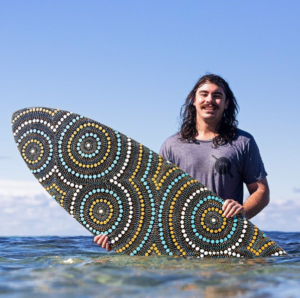
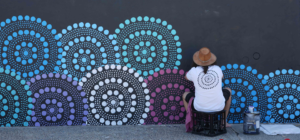
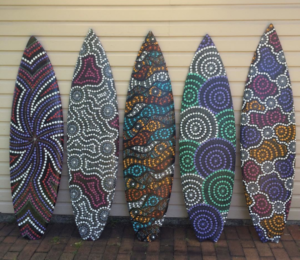
Yvonne Koolmatrie is a Ngarrindjeri woman who is also inspired by the traditions of her culture. As an adult Koolmatrie attended a workshop on traditional methods of harvesting, preparing and weaving Murray River sedge grass. Koolmatrie found that weaving helped her to overcome personal grief and gave her a portal to tell her story. Koolmatrie is probably best known for her eel trap weavings. These have aspects of traditional weaving forms with her own added innovations. She also depicts her peoples Dreaming stories of Wuluwan (River Bunyiip), Prupi (Child Stealer) and the Rainbow Serpent into woven forms. Koolmatrie sees weaving as a sustaining part of Ngarrindjeri culture and hopes to keep the practice alive through her work.
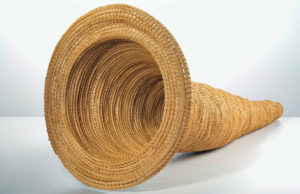
Research Yvonne Koolmatrie on the Art Gallery of NSW website and answer the following questions:
Research one of the following traditions, movements or category of Aboriginal and Torres Strait Islander Art.
Here are some ideas to get you started.
Complete an Artist Statement found inside the Art Entry Form and submit your artwork by Friday 6 September.